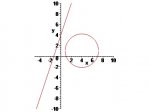Hi
i have a important test in a few months, and i have a problem with this point in the syllabus.

that point say about relative positions of a circle and a line but i search in google and i dont find something that fit in well,with what say in the syllabus. My question is, if someone can tell me what is about or where i can learn it?
i really appreciate that, thanks (sorry about how i wrote this, im not very good writting in english)
(sorry about how i wrote this, im not very good writting in english)
i have a important test in a few months, and i have a problem with this point in the syllabus.

that point say about relative positions of a circle and a line but i search in google and i dont find something that fit in well,with what say in the syllabus. My question is, if someone can tell me what is about or where i can learn it?
i really appreciate that, thanks

